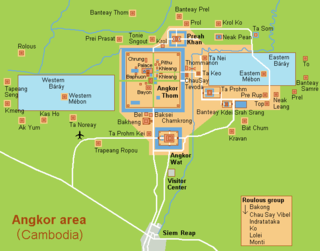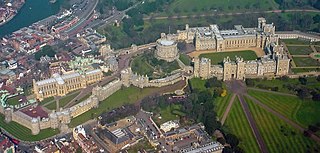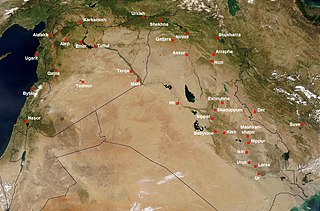Thomas Higham may refer to:
- Thomas Higham (archaeologist), archaeologist
- Thomas Higham (artist) (1795 - 1844), antiquary and topographical engraver
- Gunner Higham (1887 – after 1920), footballer, common name for Thomas Edwin Higham
Thomas Higham may refer to:

Angkor, also known as Yasodharapura, was the capital city of the Khmer Empire. The city and empire flourished from approximately the 9th to the 15th centuries. The city houses the Angkor Wat, one of Cambodia's most popular tourist attractions.
The Châtelperronian is a proposed industry of the Upper Palaeolithic, the existence of which is debated. It represents both the only Upper Palaeolithic industry made by Neanderthals and the earliest Upper Palaeolithic industry in central and southwestern France, as well as in northern Spain. It derives its name from Châtelperron, the French village closest to the type site, the cave La Grotte des Fées.
Higham may refer to:
Philip Arthur Barker was a British archaeologist who was most famous for his work on excavation methodology.

Ban Non Wat is a village in Thailand, in the Non Sung district, Nakhon Ratchasima Province, located near the small city of Phimai. It has been the subject of excavation since 2002. The cultural sequence encompasses 11 prehistoric phases, which include 640 burials. The site is associated with consistent occupation, and in modern-day Ban Non Wat the occupied village is located closer to the Mun River.
Charles Higham may refer to:

Charles Franklin Wandesforde Higham is a British-born New Zealand archaeologist most noted for his work in Southeast Asia. Among his noted contributions to archaeology are his work about the Angkor civilization in Cambodia, and his current work in Northeast Thailand. He is an emeritus professor at the University of Otago in Dunedin.

A shell keep is a style of medieval fortification, best described as a stone structure circling the top of a motte.
Bluefish Caves is an archaeological site in Yukon, Canada, located 54 km (34 mi) southwest of the Vuntut Gwichin community of Old Crow. It has been controversially suggested that human occupation radiocarbon dates to 24,000 years Before Present (BP) based on radiocarbon dating of animal remains, but these dates are contested due to the uncertain stratigraphic context of the archaeological remains relative to the dated animal remains. There are three small caves in the area.
Nicholas John Higham, is a British archaeologist, historian, and academic. He was Professor of Early Medieval and Landscape History at the University of Manchester, and is now an emeritus professor.

The Levantine corridor is the relatively narrow strip between the Mediterranean Sea to the northwest and deserts to the southeast, which connects Africa to Eurasia. This corridor is a land route of migrations of animals between Eurasia and Africa. In particular, it is believed that early hominins spread from Africa to Eurasia via the Levantine corridor and Horn of Africa. The corridor is named after the Levant.

The Areni-1 shoe is a 5,500-year-old leather shoe that was found in 2008 in excellent condition in the Areni-1 cave located in the Vayots Dzor province of Armenia. It is a one-piece leather-hide shoe, the oldest piece of leather footwear in the world known to contemporary researchers. The discovery was made by an international team led by Boris Gasparyan, an archaeologist from the Institute of Archaeology and Ethnography of the National Academy of Sciences of Armenia.
Higham is a surname with two possible origins. The first is the name based on geographical locations in England, see Higham, and was originally for people from those locations. The second is from the Hebrew word "khayim" which means life.

Khirbet en-Nahas, also spelled Khirbat en-Nahas, is one of the largest copper mining and smelting sites of the ancient world, built around 3,000 years ago. It is located in Wadi Faynan, between the Dead Sea and the Gulf of Aqaba, now in Jordan. There is evidence of sophisticated economic and political activity in the valley about 3,000 years ago and archaeologists think it may be the site of an early organized state.
Louis Malleret (1901–1970) was a French archaeologist. Malleret together with Paul Levy are credited with first reporting the archeological site An Son in Southern Vietnam.

Canterbury city walls are a sequence of defensive walls built around the city of Canterbury in Kent, England. The first city walls were built by the Romans, probably between 270 and 280 AD. These walls were constructed from stone on top of an earth bank, and protected by a ditch and wall towers. At least five gates were placed into the walls, linked to the network of Roman roads across the region. With the collapse of Roman Britain, Canterbury went into decline but the walls remained, and may have influenced the decision of Augustine to settle in the city at the end of the 6th century. The Anglo-Saxons retained the defensive walls, building chapels over most of the gates and using them to defend Canterbury against Viking incursions.
Mahendraparvata is an ancient city of the Khmer Empire era in Cambodia. The existence of the city has been known for decades, but much of it lay concealed by forest and earth. The city was uncovered by an archaeological expedition led by Jean-Baptiste Chevance and Damian Evans in 2012 with the aid of airborne laser scanning technology called LIDAR.
Tom or Thomas Higham may refer to:
Thomas Higham is an archaeological scientist and radiocarbon dating specialist. He has worked as Professor of Archaeological Science at the University of Oxford, UK, where he was the Director of the Oxford Radiocarbon Accelerator Unit (ORAU) in the Research Lab for Archaeology and the History of Art. He is best known for his work in dating the Neanderthal extinction and the arrival of modern humans in Europe. He is Professor in the Department of Evolutionary Anthropology at the University of Vienna.